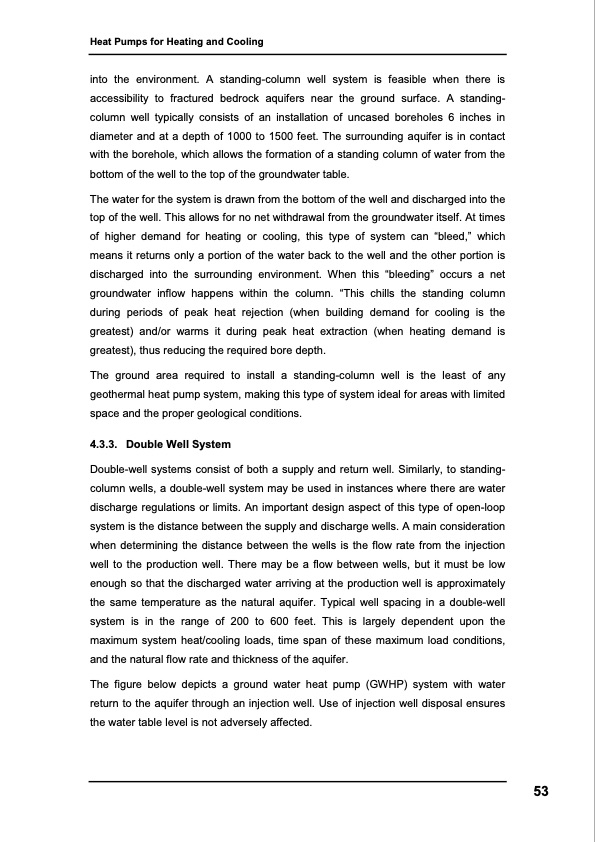
PDF Publication Title:
Text from PDF Page: 054
Heat Pumps for Heating and Cooling into the environment. A standing-column well system is feasible when there is accessibility to fractured bedrock aquifers near the ground surface. A standing- column well typically consists of an installation of uncased boreholes 6 inches in diameter and at a depth of 1000 to 1500 feet. The surrounding aquifer is in contact with the borehole, which allows the formation of a standing column of water from the bottom of the well to the top of the groundwater table. The water for the system is drawn from the bottom of the well and discharged into the top of the well. This allows for no net withdrawal from the groundwater itself. At times of higher demand for heating or cooling, this type of system can “bleed,” which means it returns only a portion of the water back to the well and the other portion is discharged into the surrounding environment. When this “bleeding” occurs a net groundwater inflow happens within the column. “This chills the standing column during periods of peak heat rejection (when building demand for cooling is the greatest) and/or warms it during peak heat extraction (when heating demand is greatest), thus reducing the required bore depth. The ground area required to install a standing-column well is the least of any geothermal heat pump system, making this type of system ideal for areas with limited space and the proper geological conditions. 4.3.3. Double Well System Double-well systems consist of both a supply and return well. Similarly, to standing- column wells, a double-well system may be used in instances where there are water discharge regulations or limits. An important design aspect of this type of open-loop system is the distance between the supply and discharge wells. A main consideration when determining the distance between the wells is the flow rate from the injection well to the production well. There may be a flow between wells, but it must be low enough so that the discharged water arriving at the production well is approximately the same temperature as the natural aquifer. Typical well spacing in a double-well system is in the range of 200 to 600 feet. This is largely dependent upon the maximum system heat/cooling loads, time span of these maximum load conditions, and the natural flow rate and thickness of the aquifer. The figure below depicts a ground water heat pump (GWHP) system with water return to the aquifer through an injection well. Use of injection well disposal ensures the water table level is not adversely affected. 53PDF Image | Heat Pumps for Heating and Cooling

PDF Search Title:
Heat Pumps for Heating and CoolingOriginal File Name Searched:
heat-pumps-for-cooling-r1.pdfDIY PDF Search: Google It | Yahoo | Bing
CO2 Organic Rankine Cycle Experimenter Platform The supercritical CO2 phase change system is both a heat pump and organic rankine cycle which can be used for those purposes and as a supercritical extractor for advanced subcritical and supercritical extraction technology. Uses include producing nanoparticles, precious metal CO2 extraction, lithium battery recycling, and other applications... More Info
Heat Pumps CO2 ORC Heat Pump System Platform More Info
| CONTACT TEL: 608-238-6001 Email: greg@infinityturbine.com | RSS | AMP |